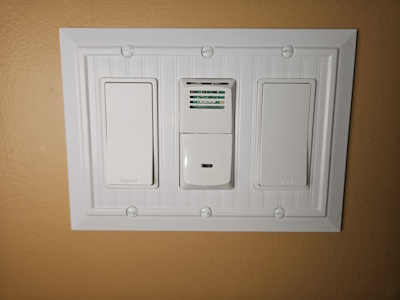I have found that running the exhaust fan in the bathroom drastically reduces the amount of discoloration of grout lines. When consistently using the fan when taking a shower and letting it continue to run for a while afterword, my need to scrub grout lines went from every couple of weeks to almost never. The issue is that I would not always remember to turn on the fan, or due to forgetting or leaving the house, letting the fan run much longer than needed. Also, guests may not typically use the bathroom fan and not turn it on. Therefore, I wanted a way to detect rises in humidity in the bathroom, automatically turn on the fan when the humidity levels reach a certain point, then turn off the fan when humidity levels have reduced back under the threshold set.
My first thought was to use a “smart” sensor in the bathrooms along with replacing the wall switch that turns the fan on and off with a “smart” switch. However, I do not like to put automation in bathrooms. When kids lived in the house I could easily see them turning things on and off in the bathroom when their sibling was using it just to mess with them. Also, the humidity sensors I found look like they could contain a camera, (even though there was not one), which I felt may make people uncomfortable. Therefore, I looked into a less high-tech solution.
I ended up replacing the wall switch controlling the fan with a Broan-NuTone P82W Sensaire Bathroom Exhaust Fan Control Wall Switch. This switch has some hidden variable resisters that you can adjust with a small screwdriver. These resisters control the sensitivity, (or at what percentage of humidity is in the air), of the humidity sensor, as well as the duration that the fan should run after humidity levels have reduced to a desirable percentage.
The main challenge with this approach is that it takes some time and experimentation to find the correct settings for the resistors. If the sensitivity is too high, then the fan will turn on at various times throughout the day due to slight changes in humidity in the house. On the other hand, if the sensitivity it too low then the fan may not turn on until all the glass surfaces are fogged over, and then not stay on long enough to bring the humidity down to a desired level. Finally, since humidity levels change naturally throughout the year, the sensitivity level should be set so that during rainstorms or other times of high humidity, the fan is not constantly turning on.
If smart sensors were distributed throughout the house as well as in the bathroom, the switch controlling the fan could be activated when the humidity levels in the bathroom were a certain percentage over the levels detected in other places around the house. However, that would go against my desire to keep “smart” devices out of the bathrooms. This would also be a much more expensive option as I would need humidity sensors in each bathroom as well as at least one more placed well away from the bathrooms, along with smart switches for each fan. Using the combined sensor and switch cost almost 80% less and with some tweaking, works well enough for me.
To initially set the levels in the sensor, I ran the shower in a bathroom to see how long it took for the fan to turn on. These tests were run over the course of several days as I wanted to make sure that humidity levels had normalized after each test. Once the sensitivity was set to a point where the fan reliably turned on within a couple minutes after the shower was turned on and the water warmed up, but not at seemingly random times throughout the day. The next step was to adjust the fan’s run-time so that once the humidity levels went below the threshold set, it would further work to reduce the humidity level in the bathroom to roughly match the rest of the house.
While this solution is not perfect, and setting up and configuring a more automated and flexible solution would have been fun, the lower-tech implementation is much less expensive and meets my goal of drastically reducing the amount of grout discoloration. At one point, after several years of showers and not using the exhaust fan, I used some very potent grout cleaner to strip off all the discoloration, then applied sealant to all the grout lines. This was a long and messy process, but the results were amazing. From that point on, I was very persistent in addressing any discoloration soon after it appeared so it would not spread further. This resulted in me having to scrub something about every two weeks. However, after regularly using an exhaust fan when taking showers, the amount of discoloration appearing has basically dropped to zero. Having the fan automated means that I do not have to remember to manually turn it on, (or ask guests to manually turn it on). Plus, I do not have to remember to turn off the fan. This is also useful if I am leaving the house soon after the shower and would have to turn off the fan before it had fully done its job.
This project, while not seeming that exciting, does so much to maintain the bathrooms without any elbow grease from me. And after going through the long, messy, process of striping grout with dangerous chemicals, then applying sealant, I can say that it is not something I care to do again. Therefore, having the fans automated in some way is, in my view, well worth the time and expense of buying and installing some switches with a humidity sensor built-in.


